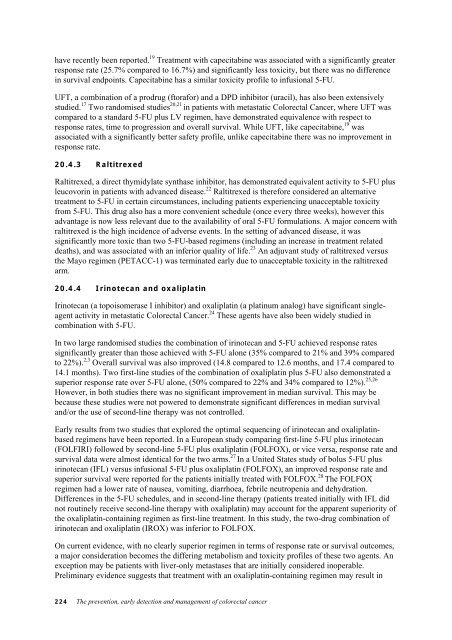Clinical Practice Guidelines - National Health and Medical Research ...
Clinical Practice Guidelines - National Health and Medical Research ...
Clinical Practice Guidelines - National Health and Medical Research ...
Create successful ePaper yourself
Turn your PDF publications into a flip-book with our unique Google optimized e-Paper software.
have recently been reported. 19 Treatment with capecitabine was associated with a significantly greater<br />
response rate (25.7% compared to 16.7%) <strong>and</strong> significantly less toxicity, but there was no difference<br />
in survival endpoints. Capecitabine has a similar toxicity profile to infusional 5-FU.<br />
UFT, a combination of a prodrug (ftorafor) <strong>and</strong> a DPD inhibitor (uracil), has also been extensively<br />
studied. 17 Two r<strong>and</strong>omised studies 20,21 in patients with metastatic Colorectal Cancer, where UFT was<br />
compared to a st<strong>and</strong>ard 5-FU plus LV regimen, have demonstrated equivalence with respect to<br />
response rates, time to progression <strong>and</strong> overall survival. While UFT, like capecitabine, 19 was<br />
associated with a significantly better safety profile, unlike capecitabine there was no improvement in<br />
response rate.<br />
20.4.3 Raltitrexed<br />
Raltitrexed, a direct thymidylate synthase inhibitor, has demonstrated equivalent activity to 5-FU plus<br />
leucovorin in patients with advanced disease. 22 Raltitrexed is therefore considered an alternative<br />
treatment to 5-FU in certain circumstances, including patients experiencing unacceptable toxicity<br />
from 5-FU. This drug also has a more convenient schedule (once every three weeks), however this<br />
advantage is now less relevant due to the availability of oral 5-FU formulations. A major concern with<br />
raltitrexed is the high incidence of adverse events. In the setting of advanced disease, it was<br />
significantly more toxic than two 5-FU-based regimens (including an increase in treatment related<br />
deaths), <strong>and</strong> was associated with an inferior quality of life. 23 An adjuvant study of raltitrexed versus<br />
the Mayo regimen (PETACC-1) was terminated early due to unacceptable toxicity in the raltitrexed<br />
arm.<br />
20.4.4 Irinotecan <strong>and</strong> oxaliplatin<br />
Irinotecan (a topoisomerase I inhibitor) <strong>and</strong> oxaliplatin (a platinum analog) have significant singleagent<br />
activity in metastatic Colorectal Cancer. 24 These agents have also been widely studied in<br />
combination with 5-FU.<br />
In two large r<strong>and</strong>omised studies the combination of irinotecan <strong>and</strong> 5-FU achieved response rates<br />
significantly greater than those achieved with 5-FU alone (35% compared to 21% <strong>and</strong> 39% compared<br />
to 22%). 2,3 Overall survival was also improved (14.8 compared to 12.6 months, <strong>and</strong> 17.4 compared to<br />
14.1 months). Two first-line studies of the combination of oxaliplatin plus 5-FU also demonstrated a<br />
superior response rate over 5-FU alone, (50% compared to 22% <strong>and</strong> 34% compared to 12%). 25,26<br />
However, in both studies there was no significant improvement in median survival. This may be<br />
because these studies were not powered to demonstrate significant differences in median survival<br />
<strong>and</strong>/or the use of second-line therapy was not controlled.<br />
Early results from two studies that explored the optimal sequencing of irinotecan <strong>and</strong> oxaliplatinbased<br />
regimens have been reported. In a European study comparing first-line 5-FU plus irinotecan<br />
(FOLFIRI) followed by second-line 5-FU plus oxaliplatin (FOLFOX), or vice versa, response rate <strong>and</strong><br />
survival data were almost identical for the two arms. 27 In a United States study of bolus 5-FU plus<br />
irinotecan (IFL) versus infusional 5-FU plus oxaliplatin (FOLFOX), an improved response rate <strong>and</strong><br />
superior survival were reported for the patients initially treated with FOLFOX. 28 The FOLFOX<br />
regimen had a lower rate of nausea, vomiting, diarrhoea, febrile neutropenia <strong>and</strong> dehydration.<br />
Differences in the 5-FU schedules, <strong>and</strong> in second-line therapy (patients treated initially with IFL did<br />
not routinely receive second-line therapy with oxaliplatin) may account for the apparent superiority of<br />
the oxaliplatin-containing regimen as first-line treatment. In this study, the two-drug combination of<br />
irinotecan <strong>and</strong> oxaliplatin (IROX) was inferior to FOLFOX.<br />
On current evidence, with no clearly superior regimen in terms of response rate or survival outcomes,<br />
a major consideration becomes the differing metabolism <strong>and</strong> toxicity profiles of these two agents. An<br />
exception may be patients with liver-only metastases that are initially considered inoperable.<br />
Preliminary evidence suggests that treatment with an oxaliplatin-containing regimen may result in<br />
224 The prevention, early detection <strong>and</strong> management of colorectal cancer

















